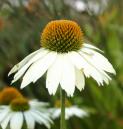Synonym.—Chaulmoogra Oil.
Gynocardia oil is obtained by expression from the seeds of Taraktogenos Kurzii, King (N.O. Bixineae), a native of Burmah. It is official in India and the Eastern Colonies. Gynocardia oil occurs as a solid fat of varying consistence, or as a brownish-yellow oil in warm weather, having a characteristic odour, a somewhat acrid taste, and an acid reaction. Specific gravity, 0.951 at 25% 0.940 at 45°; optical rotation, +52°; melting-point, 22° to 23°; acid value, 23.9; saponification value, 213; iodine value, 103.2. A mixture of 1 mil with 0.5 decimil (0.05 milliliters) of sulphuric acid acquires a reddish-brown colour, changing to olive-green.
Soluble in ether, chloroform, or carbon bisulphide; alcohol dissolves the greater part of the oil, repeated treatment with warm alcohol dissolving the remainder.
Constituents.—The oil contains chaulmoogric acid (C18H32O2), and also palmitic acid. On hydrolysis the fatty oil has been found to yield glycerol, a very small quantity of phytosterol (C26H43OH), and a mixture of fatty acids (melting-point, 44° to 45°). Gynocardic acid, so-called, is a mixture of several substances.
Action and Uses.—Gynocardia oil is employed externally in the treatment of rheumatism, psoriasis, eczema, and other chronic skin diseases; and externally and internally in leprosy. On account of its disagreeable taste it is usually administered in capsules. It may be applied to the skin unmixed, or as Unguentum Gynocardiae. Gynocardic acid (dose, 3 to 12 centigrams-½ to 2 grains) and magnesium gynocardate (dose, 6 to 18 centigrams-1 to 3 grains) are given internally in leprosy, usually in pills or enclosed in capsules, but reliable evidence as to their effects is wanting'
Dose.—¼ or ½ mil increased to 4 mils (5 or 10 to 60 minims).
PREPARATION.
- Unguentum Gynocardiae, I.C.A.—GYNOCARDIA OINTMENT. Syn.—Unguentum Chaulmoograe; Chaulmoogra Ointment.
- Gynocardia oil, by weight, 10; hard paraffin, 40; soft paraffin, white, 50 Melt together the hard and soft paraffins, add the oil, and stir until cold. This ointment is applied to the skin in leprosy, and in chronic skin diseases.

